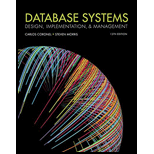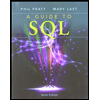
Concept explainers
Aggregate Functions:
SQL has some built-in functions and they are called as aggregate functions. SQL contains five built-in functions. They are:
- SUM – This function is used to add values from the particular column.
- Syntax: SELECT SUM(column_Name) FROM table_Name;
- COUNT – This is used to count the number of rows for the particular column.
- Syntax: SELECT COUNT(column_Name) FROM table_Name;
- MAX – This function is used to get the maximum value from the column.
- Syntax: SELECT MAX(column_Name) FROM table_Name;
- MIN – This function is used to get the minimum value from the column.
- Syntax: SELECT MIN(column_Name) FROM table_Name;
- AVG – This function is used to get the average of all the values from the column.
- Syntax: SELECT AVG(column_Name) FROM table_Name;
“ORDER BY” Clause:
SQL contains “ORDER BY” clause in order to sort rows. The values get sorted in ascending and descending order. The keyword used to sort values in ascending order is “ASC” and for descending order is “DESC”. By default, it sorts values by ascending order.
Syntax:
SELECT column_Name1, column_Name2 FROM table_Name ORDER BY column_Name2;
Join:
Join is a relational operation, which combines the data from two or more tablesinto single table or view, then that is called as Join.
Inner join:
The “inner join” keyword is to select the matching records from two tables. The syntax of “inner join” is as follows:
Syntax:
SELECT column_name FROM table1 INNER JOIN table2 ON table1.column_name=table2.column_name;
“AND” operator:
The operator used to check two or more conditions using single query. The “AND” operator returns “true” when two conditions are satisfied in the query.
“UNION” operator:
The UNION set operator is used to combine the output of two or more than two queries and produce a result. The produced result contains unique values.
Syntax: QUERY UNION QUERY;
“NOT IN” operator:
The “NOT IN” operator used to select not matching rows from appropriate tables.
Syntax: SELECT column_name1, column_name2, column_nameN FROM table_name WHERE column_name1 NOT IN column_name2;
Trending nowThis is a popular solution!

Chapter 7 Solutions
Database Systems: Design, Implementation, & Management
- Can I get help with this case please, thank youarrow_forwardI need help to solve the following, thank youarrow_forwardreminder it an exercice not a grading work GETTING STARTED Open the file SC_EX19_EOM2-1_FirstLastNamexlsx, available for download from the SAM website. Save the file as SC_EX19_EOM2-1_FirstLastNamexlsx by changing the “1” to a “2”. If you do not see the .xlsx file extension in the Save As dialog box, do not type it. The program will add the file extension for you automatically. With the file SC_EX19_EOM2-1_FirstLastNamexlsx still open, ensure that your first and last name is displayed in cell B6 of the Documentation sheet. If cell B6 does not display your name, delete the file and download a new copy from the SAM website. Brad Kauffman is the senior director of projects for Rivera Engineering in Miami, Florida. The company performs engineering projects for public utilities and energy companies. Brad has started to create an Excel workbook to track estimated and actual hours and billing amounts for each project. He asks you to format the workbook to make the…arrow_forward
- Need help with coding in this in python!arrow_forwardIn the diagram, there is a green arrow pointing from Input C (complete data) to Transformer Encoder S_B, which I don’t understand. The teacher model is trained on full data, but S_B should instead receive missing data—this arrow should not point there. Please verify and recreate the diagram to fix this issue. Additionally, the newly created diagram should meet the same clarity standards as the second diagram (Proposed MSCATN). Finally provide the output image of the diagram in image format .arrow_forwardPlease provide me with the output image of both of them . below are the diagrams code make sure to update the code and mentionned clearly each section also the digram should be clearly describe like in the attached image. please do not provide the same answer like in other question . I repost this question because it does not satisfy the requirment I need in terms of clarifty the output of both code are not very well details I have two diagram : first diagram code graph LR subgraph Teacher Model (Pretrained) Input_Teacher[Input C (Complete Data)] --> Teacher_Encoder[Transformer Encoder T] Teacher_Encoder --> Teacher_Prediction[Teacher Prediction y_T] Teacher_Encoder --> Teacher_Features[Internal Features F_T] end subgraph Student_A_Model[Student Model A (Handles Missing Values)] Input_Student_A[Input M (Data with Missing Values)] --> Student_A_Encoder[Transformer Encoder E_A] Student_A_Encoder --> Student_A_Prediction[Student A Prediction y_A] Student_A_Encoder…arrow_forward
 Database Systems: Design, Implementation, & Manag...Computer ScienceISBN:9781305627482Author:Carlos Coronel, Steven MorrisPublisher:Cengage Learning
Database Systems: Design, Implementation, & Manag...Computer ScienceISBN:9781305627482Author:Carlos Coronel, Steven MorrisPublisher:Cengage Learning Database Systems: Design, Implementation, & Manag...Computer ScienceISBN:9781285196145Author:Steven, Steven Morris, Carlos Coronel, Carlos, Coronel, Carlos; Morris, Carlos Coronel and Steven Morris, Carlos Coronel; Steven Morris, Steven Morris; Carlos CoronelPublisher:Cengage Learning
Database Systems: Design, Implementation, & Manag...Computer ScienceISBN:9781285196145Author:Steven, Steven Morris, Carlos Coronel, Carlos, Coronel, Carlos; Morris, Carlos Coronel and Steven Morris, Carlos Coronel; Steven Morris, Steven Morris; Carlos CoronelPublisher:Cengage Learning A Guide to SQLComputer ScienceISBN:9781111527273Author:Philip J. PrattPublisher:Course Technology Ptr
A Guide to SQLComputer ScienceISBN:9781111527273Author:Philip J. PrattPublisher:Course Technology Ptr



